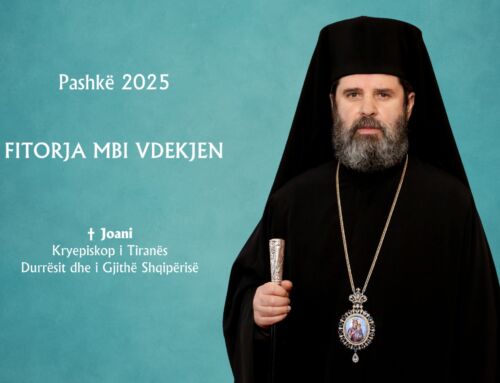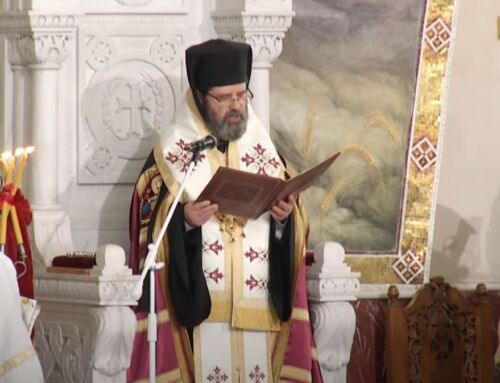Inner Struggles
At the beginning of the fifth century when Alexandria and Constantinople were feuding over their respective positions in the Church and in the empire, Nestorius, the bishop of Constantinople, made known his refusal to honor Mary, Christ’s mother, with the traditional title of Theotokos. He claimed that the one born from Mary is merely the “man” in whom the eternal Logos of God came to dwell, but not the Logos Himself. Thus, Mary could not properly be called Theotokos, which means the one who gave birth to God.
Saint Cyril, the bishop of Alexandria (d.444), forcefully rejected the teaching of Nestorius, claiming that it is proper to call Mary Theotokos since the one born from her, “according to the flesh,” is none other than the divine Logos of God. The only-begotten Son of God was “begotten of the Father before all ages” coming down from Heaven for man’s salvation, being born in the flesh, and becoming man from the Virgin. Thus, the Son of God and the Son of Mary is one and the same Son.
The Third Ecumenical Council
Nestorius and his followers refused to yield to Saint Cyril’s appeals for repentance. Thus, in 431, in the city of Ephesus, a small group of bishops under Saint Cyril’s direct control held a council to affirm the Alexandrian doctrine and to reject that of Nestorius. The decisions of this meeting were formally recognized in 433 by the Eastern bishops who had not been present. The Council of 431 subsequently became known as the Third Ecumenical Council.
The Robber Council
Again the decisions of this council were not immediately accepted. Controversy over the issue in question continued to rage. Saint Cyril and the majority of the Eastern bishops – who were inclined to oppose his teaching because of their fear that it did not adequately express the genuine humanity of Jesus – were able to come to a common understanding. After his death, however, Cyril’s fanatical followers again broke with the bishops of Constantinople and the East. In 449, a large number of bishops who considered themselves faithful to Saint Cyril’s position, held another council in Ephesus. This council came to be known as the latrocinium or robber council. It formulated a doctrine about the person and nature of Christ which so stressed the Lord’s divinity that His humanity all but completely disappeared. Thus, confusion and division continued to exist among Christians.
The Fourth Ecumenical Council
In 451, another council was called, this time in the city of Chalcedon, to solve the problem of the doctrine of Christ. This council, now recognized in the Church as the Fourth Ecumenical Council, succeeded in defending the teaching of Saint Cyril and the Ephesian Council of 431. It also satisfied the demands of the Eastern bishops that the genuine humanity of Jesus would be clearly confessed. In its definition, the Council of Chalcedon closely followed the teaching, formulated in a letter, of Pope Saint Leo of Rome.
The Chalcedonian definition states that Jesus Christ is indeed the Logos incarnate, the very Son of God “born of the Father before all ages.” It affirms that the Virgin Mary is truly Theotokos since the one born from her “according to the flesh” in Bethlehem, is the uncreated, divine Son of God, one of the Holy Trinity. In His human birth, the Council declared, the Word of God took to Himself the whole of humanity, becoming a real man in every way, but without sin. Thus, according to the Chalcedonian definition, Jesus of Nazareth is one person or hypostasis in two natures – human and divine. He is fully human. He is fully divine. He is perfect God and perfect man. As God, He is “of one essence” (homoousios) with God the Father and the Holy Spirit. As man, He is “of one essence” (homoousios) with all human beings.
The union of divinity and humanity in Christ is called the hypostatic union. This expression means that in the one, unique person of Christ, divinity and humanity are united in such a way that they are neither mixed together and confused, nor separated and divided. Christ is one person Who is both human and divine. The Son of God and the Son of Mary is one and the same person.
The Monophysites
The decision of the Council of Chalcedon was not accepted by the extreme disciples of Saint Cyril of Alexandria, nor by those who came to be associated with them. These Christians, called monophysites, rejected the Chalcedonian Council on the basis that the council spoke of two natures, thus rejecting the old formula of Saint Cyril which claimed that in His incarnation, Christ has but one nature. The supporters of the Chalcedonian decision claimed and still claim that though their words are different from those of the holy father, their doctrine is exactly the same and is simply expressed with greater precision. The disagreement was never settled, however, and although many attempts at reunion were made in the fifth and sixth centuries – and again in recent years – the dissenters from the Chalcedonian decision remain separated from the Orthodox Church.
Today, the so-called Monophysite Christians are in the Coptic Church of Egypt, the Ethiopian Church, the Syrian Jacobite Church, the Syrian Church of India, and the Armenian Church. These churches are often called the Lesser Eastern Churches or the Oriental Orthodox Churches.
The Councils
The Third and Fourth Ecumenical Councils made a number of canons of a disciplinary and practical nature. The Council of Ephesus forbade the composition of a “different faith” from that of the first two councils (Canon 7). This canon has been used by the Orthodox in opposition to the addition of the word filioque to the Creed as it came to be used in the Western Churches. The Council of Chalcedon gave to Constantinople, the New Rome, “equal privileges with the old imperial Rome” because the new capital city was “honored with the emperor and the senate” (Canon 28).
The West
The fifth century witnessed the decline of the Christian empire in the West with the fall of Rome to the barbarians. The inception of the Western dark ages followed quickly after the death of a man whose voluminous and highly debated writings exercised the greatest single influence in Western Christianity, both Roman and Reformed: Augustine, the bishop of Hippo (d.430)


